Abstract
OBJECTIVES: This study evaluated the risks of sternal wound infections in patients undergoing myocardial revascularization using bilateral skeletonized internal mammary arteries (IMAs). BACKGROUND: The skeletonized IMA is longer than the pedicled one, thus providing the cardiac surgeon with increased versatility for arterial myocardial revascularization without the use of vein grafts. It is isolated from the chest wall gently with scissors and silver clips, and no cauterization is employed. Preservation of collateral blood supply to the sternum and avoidance of thermal injury enable more rapid healing and decrease the risk of sternal wound infection. METHODS: From April 1996 to August 1997, 545 patients underwent arterial myocardial revascularization using bilateral skeletonized IMAs. The right gastroepiploic artery was used in 100 patients (18%). The average age of the patients was 65 years; 431 (79%) were men and 114 (21%) were women; 179 (33%) were older than 70 years of age; 166 (30%) were diabetics. The average number of grafts was 3.2 per patient. RESULTS: The 30-day operative mortality rate was 2% (n = 11). There were six perioperative infarcts (1.1%) and six strokes (1.1%); 9 patients had sternal infection (1.7%) and 15 (2.8%) had superficial infection. Risk factors for sternal infection were chronic obstructive pulmonary disease and emergency operation. Superficial sternal wound infections were more common in women and in patients with chronic obstructive pulmonary disease, renal failure, or peripheral vascular disease. The 1-year actuarial survival rate was 97%. Two of the six late deaths were not cardiac-related. Late dehiscence occurred in three patients (0.6%). The death rate (early and late) of patients with any sternal complication was higher than that of patients without those complications (33% vs. 2.7%). CONCLUSIONS: Routine arterial myocardial revascularization using bilateral skeletonized IMAs is safe, and postoperative morbidity and mortality rates are low, even in elderly patients and those with diabetes. Chronic obstructive pulmonary disease and emergency operations were found to be associated with an increased risk of sternal infections, and the authors recommend avoiding the use of bilateral skeletonized IMAs in patients with these preoperative risk factors.
Full text
PDF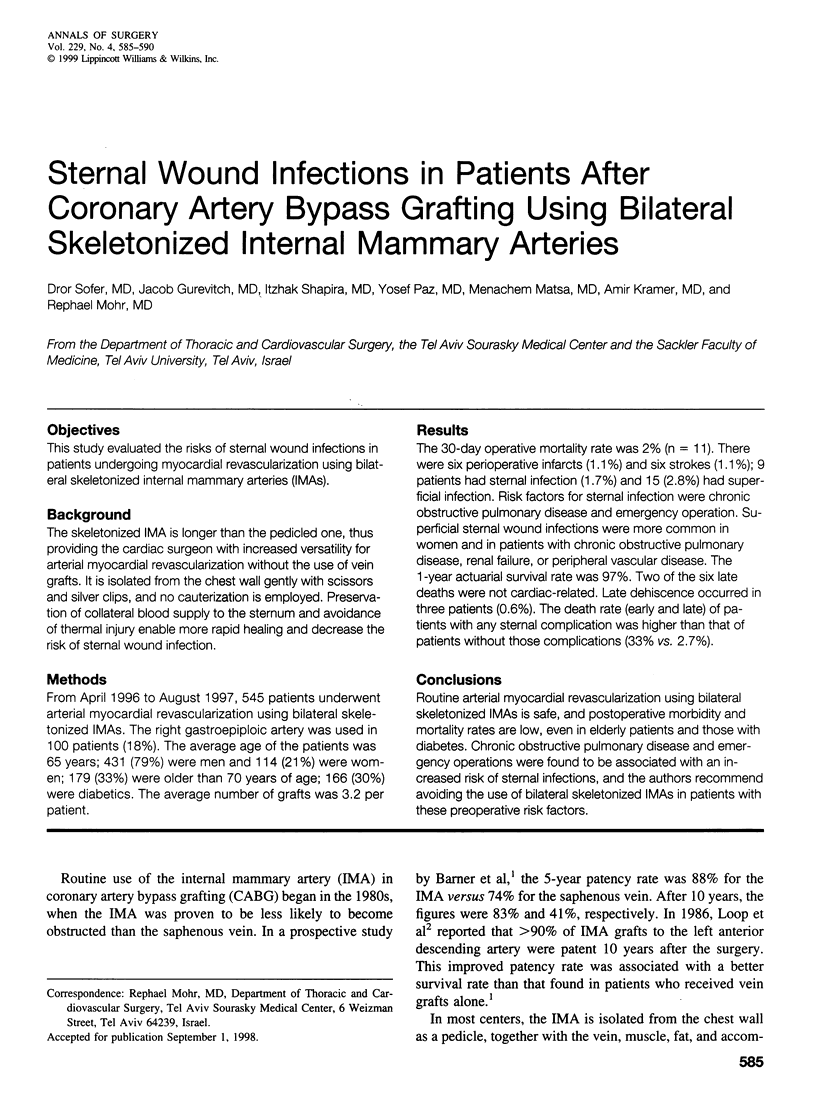
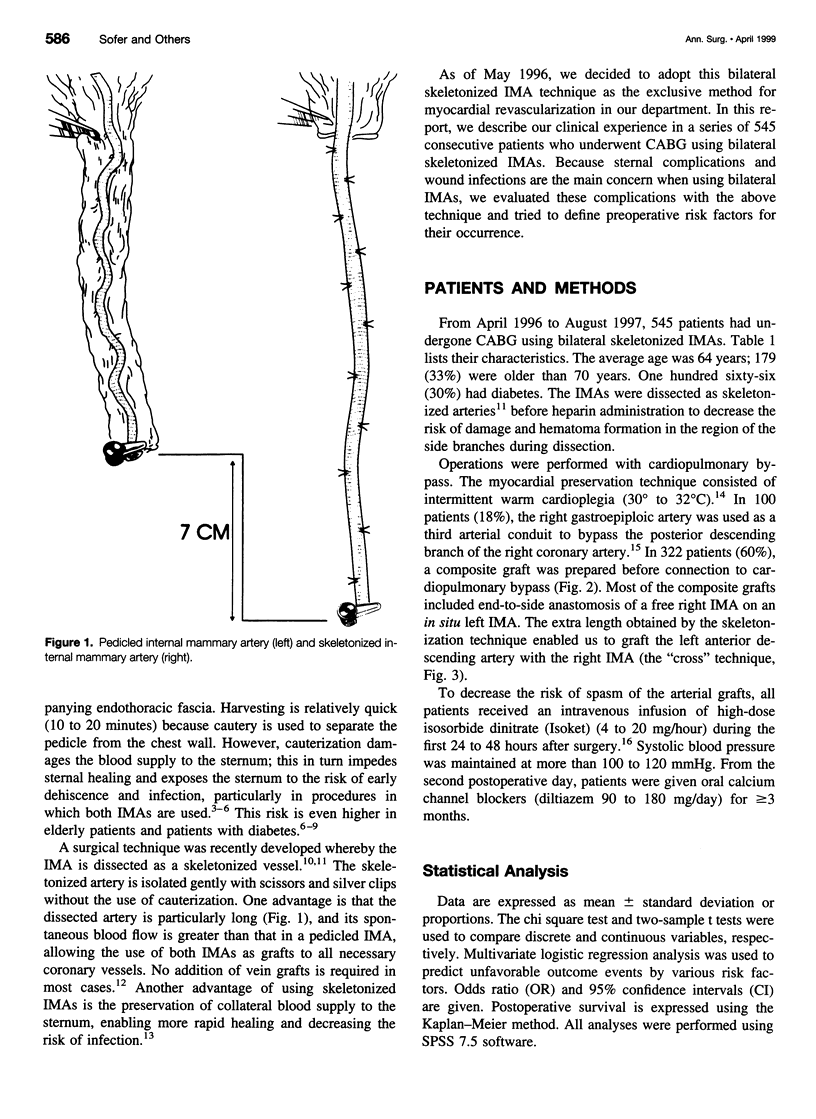
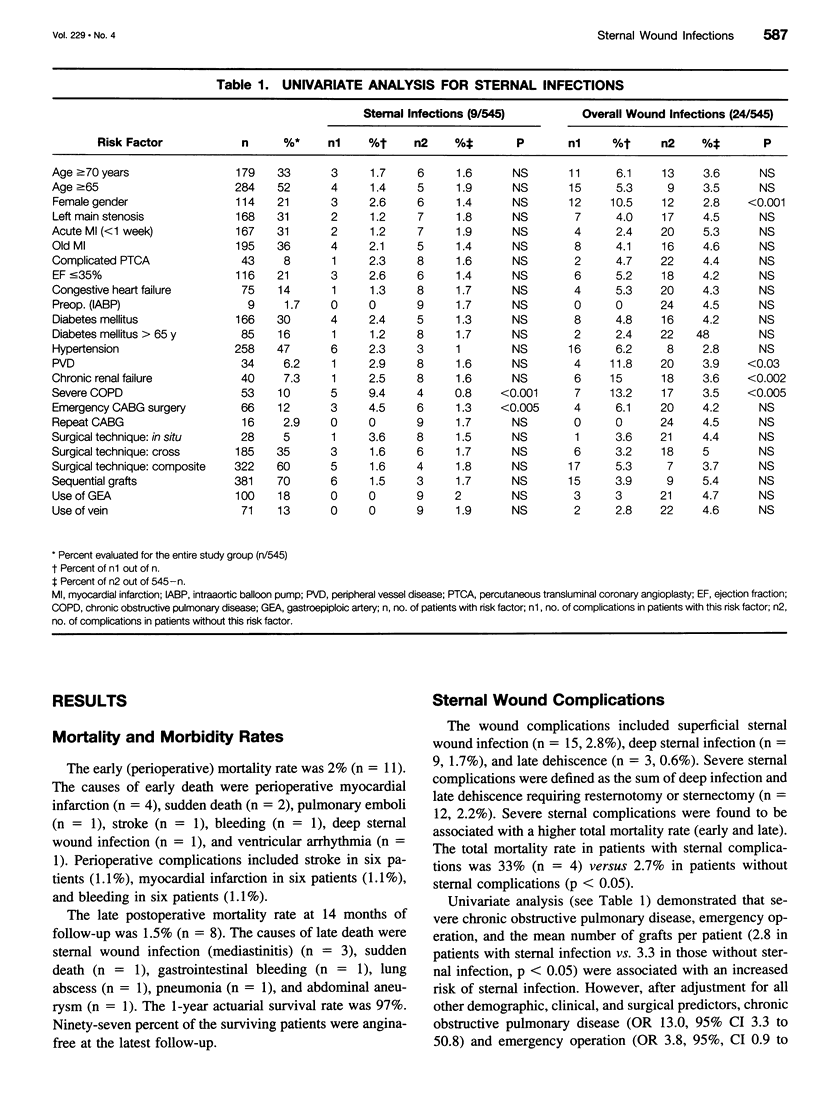
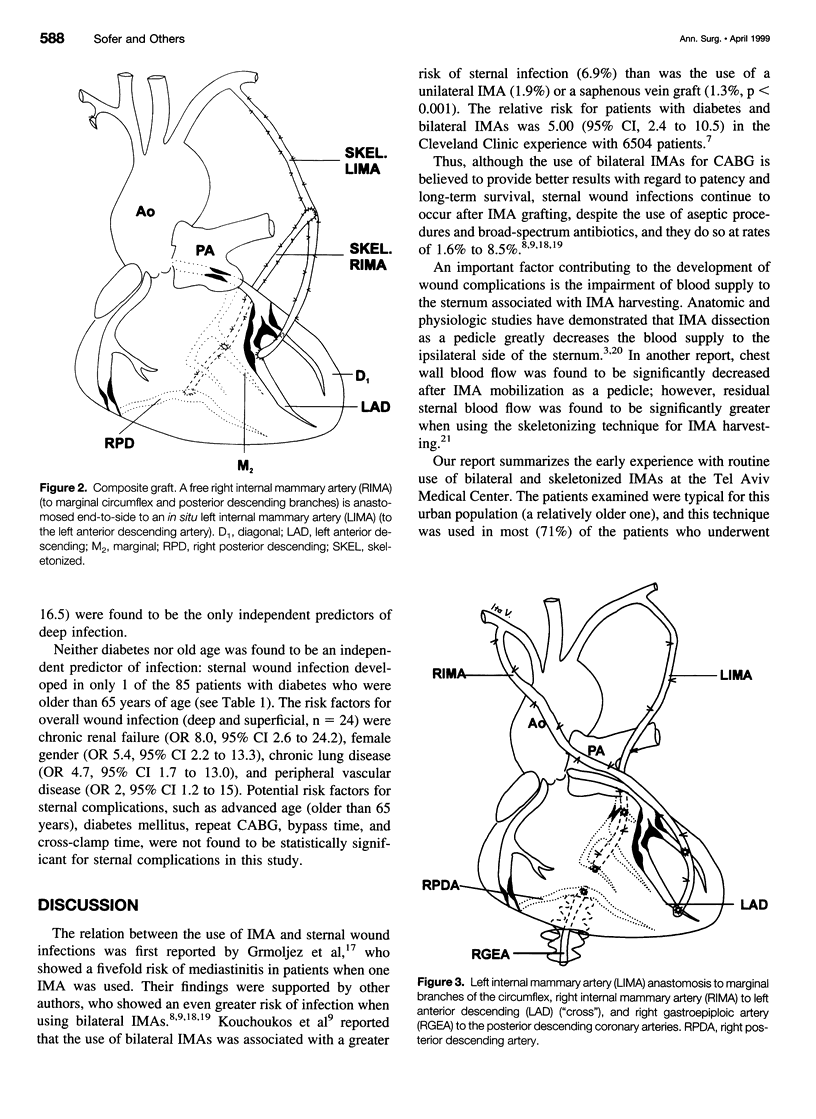
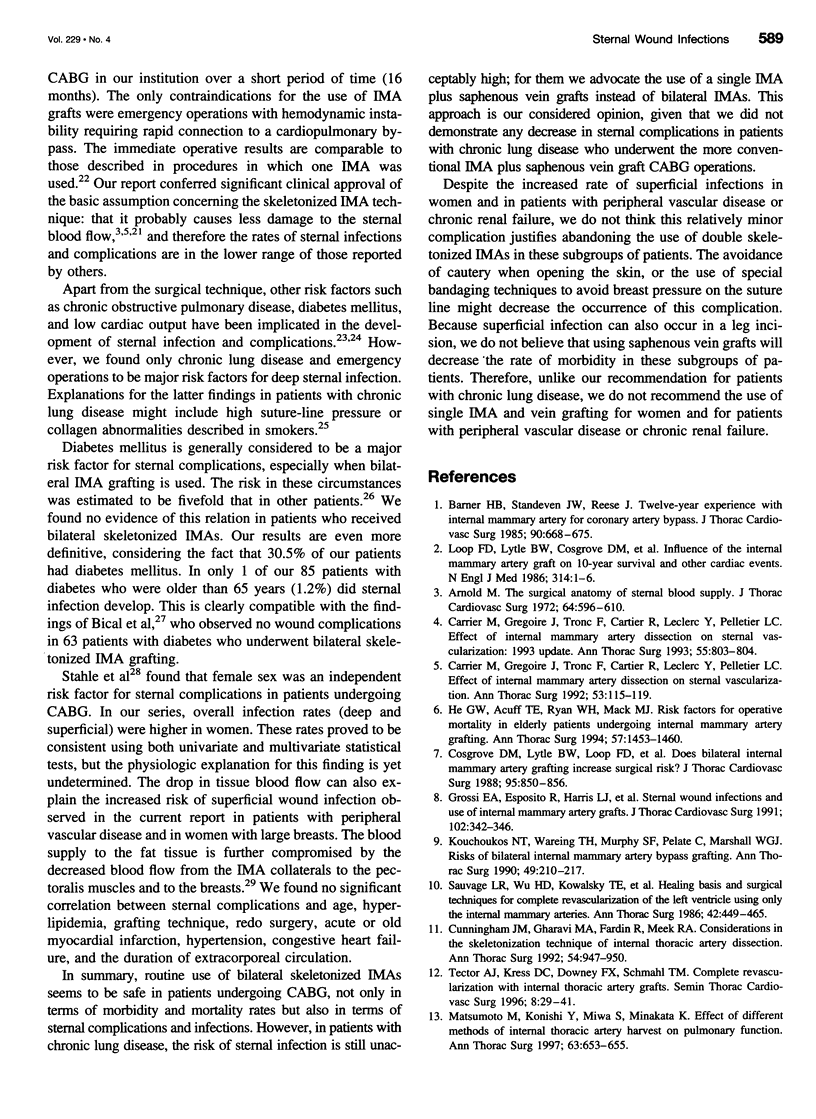
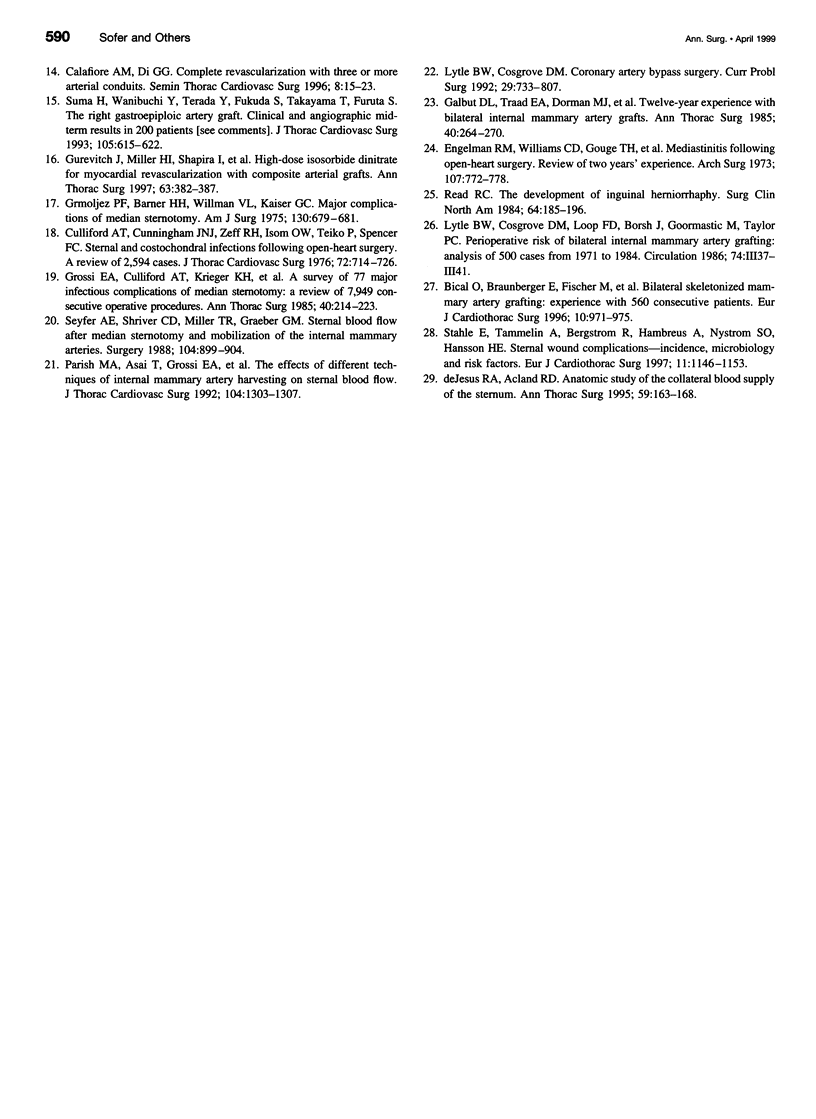
Selected References
These references are in PubMed. This may not be the complete list of references from this article.
- Arnold M. The surgical anatomy of sternal blood supply. J Thorac Cardiovasc Surg. 1972 Oct;64(4):596–610. [PubMed] [Google Scholar]
- Barner H. B., Standeven J. W., Reese J. Twelve-year experience with internal mammary artery for coronary artery bypass. J Thorac Cardiovasc Surg. 1985 Nov;90(5):668–675. [PubMed] [Google Scholar]
- Bical O., Braunberger E., Fischer M., Robinault J., Foiret J. C., Fromes Y., Gaillard D., Maribas P., Bouharaoua T., Souffrant G. Bilateral skeletonized mammary artery grafting: experience with 560 consecutive patients. Eur J Cardiothorac Surg. 1996;10(11):971–976. doi: 10.1016/s1010-7940(96)80399-x. [DOI] [PubMed] [Google Scholar]
- Calafiore A. M., Di Giammarco G. Complete revascularization with three or more arterial conduits. Semin Thorac Cardiovasc Surg. 1996 Jan;8(1):15–23. [PubMed] [Google Scholar]
- Carrier M., Grégoire J., Tronc F., Cartier R., Leclerc Y., Pelletier L. C. 1992: Effect of internal mammary artery dissection on sternal vascularization. 1993 update. Ann Thorac Surg. 1993 Mar;55(3):803–804. doi: 10.1016/0003-4975(93)90306-3. [DOI] [PubMed] [Google Scholar]
- Carrier M., Grégoire J., Tronc F., Cartier R., Leclerc Y., Pelletier L. C. Effect of internal mammary artery dissection on sternal vascularization. Ann Thorac Surg. 1992 Jan;53(1):115–119. doi: 10.1016/0003-4975(92)90768-y. [DOI] [PubMed] [Google Scholar]
- Cosgrove D. M., Lytle B. W., Loop F. D., Taylor P. C., Stewart R. W., Gill C. C., Golding L. A., Goormastic M. Does bilateral internal mammary artery grafting increase surgical risk? J Thorac Cardiovasc Surg. 1988 May;95(5):850–856. [PubMed] [Google Scholar]
- Culliford A. T., Cunningham J. N., Jr, Zeff R. H., Isom O. W., Teiko P., Spencer F. C. Sternal and costochondral infections following open-heart surgery. A review of 2,594 cases. J Thorac Cardiovasc Surg. 1976 Nov;72(5):714–726. [PubMed] [Google Scholar]
- Cunningham J. M., Gharavi M. A., Fardin R., Meek R. A. Considerations in the skeletonization technique of internal thoracic artery dissection. Ann Thorac Surg. 1992 Nov;54(5):947–951. doi: 10.1016/0003-4975(92)90656-o. [DOI] [PubMed] [Google Scholar]
- Engelman R. M., Williams C. D., Gouge T. H., Chase R. M., Jr, Falk E. A., Boyd A. D., Reed G. E. Mediastinitis following open-heart surgery. Review of two years' experience. Arch Surg. 1973 Nov;107(5):772–778. doi: 10.1001/archsurg.1973.01350230124022. [DOI] [PubMed] [Google Scholar]
- Galbut D. L., Traad E. A., Dorman M. J., DeWitt P. L., Larsen P. B., Weinstein D., Ally J. M., Gentsch T. O. Twelve-year experience with bilateral internal mammary artery grafts. Ann Thorac Surg. 1985 Sep;40(3):264–270. doi: 10.1016/s0003-4975(10)60039-2. [DOI] [PubMed] [Google Scholar]
- Grmoljez P. F., Barner H. H., Willman V. L., Kaiser G. C. Major complications of median sternotomy. Am J Surg. 1975 Dec;130(6):679–681. doi: 10.1016/0002-9610(75)90419-5. [DOI] [PubMed] [Google Scholar]
- Grossi E. A., Culliford A. T., Krieger K. H., Kloth D., Press R., Baumann F. G., Spencer F. C. A survey of 77 major infectious complications of median sternotomy: a review of 7,949 consecutive operative procedures. Ann Thorac Surg. 1985 Sep;40(3):214–223. doi: 10.1016/s0003-4975(10)60030-6. [DOI] [PubMed] [Google Scholar]
- Grossi E. A., Esposito R., Harris L. J., Crooke G. A., Galloway A. C., Colvin S. B., Culliford A. T., Baumann F. G., Yao K., Spencer F. C. Sternal wound infections and use of internal mammary artery grafts. J Thorac Cardiovasc Surg. 1991 Sep;102(3):342–347. [PubMed] [Google Scholar]
- Gurevitch J., Miller H. I., Shapira I., Kramer A., Paz Y., Matsa M., Mohr R., Yakirevich V. High-dose isosorbide dinitrate for myocardial revascularization with composite arterial grafts. Ann Thorac Surg. 1997 Feb;63(2):382–387. doi: 10.1016/s0003-4975(96)00923-x. [DOI] [PubMed] [Google Scholar]
- He G. W., Acuff T. E., Ryan W. H., Mack M. J. Risk factors for operative mortality in elderly patients undergoing internal mammary artery grafting. Ann Thorac Surg. 1994 Jun;57(6):1453–1461. doi: 10.1016/0003-4975(94)90100-7. [DOI] [PubMed] [Google Scholar]
- Kouchoukos N. T., Wareing T. H., Murphy S. F., Pelate C., Marshall W. G., Jr Risks of bilateral internal mammary artery bypass grafting. Ann Thorac Surg. 1990 Feb;49(2):210–219. doi: 10.1016/0003-4975(90)90140-2. [DOI] [PubMed] [Google Scholar]
- Loop F. D., Lytle B. W., Cosgrove D. M., Stewart R. W., Goormastic M., Williams G. W., Golding L. A., Gill C. C., Taylor P. C., Sheldon W. C. Influence of the internal-mammary-artery graft on 10-year survival and other cardiac events. N Engl J Med. 1986 Jan 2;314(1):1–6. doi: 10.1056/NEJM198601023140101. [DOI] [PubMed] [Google Scholar]
- Lytle B. W., Cosgrove D. M., 3rd Coronary artery bypass surgery. Curr Probl Surg. 1992 Oct;29(10):733–807. doi: 10.1016/0011-3840(92)90016-v. [DOI] [PubMed] [Google Scholar]
- Matsumoto M., Konishi Y., Miwa S., Minakata K. Effect of different methods of internal thoracic artery harvest on pulmonary function. Ann Thorac Surg. 1997 Mar;63(3):653–655. doi: 10.1016/s0003-4975(96)01032-6. [DOI] [PubMed] [Google Scholar]
- Parish M. A., Asai T., Grossi E. A., Esposito R., Galloway A. C., Colvin S. B., Spencer F. C. The effects of different techniques of internal mammary artery harvesting on sternal blood flow. J Thorac Cardiovasc Surg. 1992 Nov;104(5):1303–1307. [PubMed] [Google Scholar]
- Read R. C. The development of inguinal herniorrhaphy. Surg Clin North Am. 1984 Apr;64(2):185–196. doi: 10.1016/s0039-6109(16)43278-0. [DOI] [PubMed] [Google Scholar]
- Sauvage L. R., Wu H. D., Kowalsky T. E., Davis C. C., Smith J. C., Rittenhouse E. A., Hall D. G., Mansfield P. B., Mathisen S. R., Usui Y. Healing basis and surgical techniques for complete revascularization of the left ventricle using only the internal mammary arteries. Ann Thorac Surg. 1986 Oct;42(4):449–465. doi: 10.1016/s0003-4975(10)60557-7. [DOI] [PubMed] [Google Scholar]
- Seyfer A. E., Shriver C. D., Miller T. R., Graeber G. M. Sternal blood flow after median sternotomy and mobilization of the internal mammary arteries. Surgery. 1988 Nov;104(5):899–904. [PubMed] [Google Scholar]
- Ståhle E., Tammelin A., Bergström R., Hambreus A., Nyström S. O., Hansson H. E. Sternal wound complications--incidence, microbiology and risk factors. Eur J Cardiothorac Surg. 1997 Jun;11(6):1146–1153. doi: 10.1016/s1010-7940(97)01210-4. [DOI] [PubMed] [Google Scholar]
- Suma H., Wanibuchi Y., Terada Y., Fukuda S., Takayama T., Furuta S. The right gastroepiploic artery graft. Clinical and angiographic midterm results in 200 patients. J Thorac Cardiovasc Surg. 1993 Apr;105(4):615–623. [PubMed] [Google Scholar]
- Tector A. J., Kress D. C., Downey F. X., Schmahl T. M. Complete revascularization with internal thoracic artery grafts. Semin Thorac Cardiovasc Surg. 1996 Jan;8(1):29–41. [PubMed] [Google Scholar]
- de Jesus R. A., Acland R. D. Anatomic study of the collateral blood supply of the sternum. Ann Thorac Surg. 1995 Jan;59(1):163–168. doi: 10.1016/0003-4975(94)00722-J. [DOI] [PubMed] [Google Scholar]


